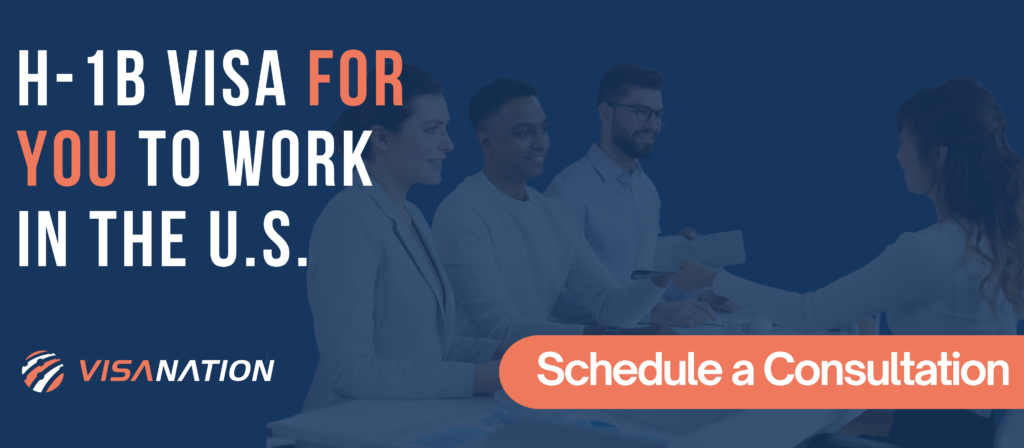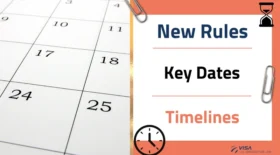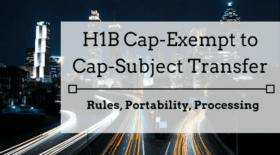With increasing demand for cap-subject H-1B visas, it’s important to understand all your options for securing a chance to live and work in the United States. One such pathway involves securing an H-1B cap-exempt job through cap-exempt organizations.
In other words, you can find cap-exempt H-1B jobs through eligible companies such as certain nonprofits, research institutions, and universities, which can sponsor H-1B visas year-round, bypassing the H-1B Visa lottery.
In this guide, learn all about what H-1B cap-exemption means and the eligibility criteria for organizations and employees. We also help you find top H-1B cap-exempt jobs, employer lists, and databases, as well as help you determine whether it’s in your best interest to have an immigration lawyer to support you in navigating the complex process.
Questions about H-1B cap exemption? Speak with a qualified immigration attorney
Latest News and Updates
- The H-1B visa lottery fee increased to $215 last year in April 2024.
- The new version of the I-129 form went into effect on January 17, 2025
- BREAKING NEWS: The H-1B petition filing window officially closed on June 30th, 2025. Don’t miss your chance next year—talk to an immigration expert.
-
President Trump has signed a new proclamation introducing a $100,000 fee for new H-1B petitions. This change could impact employers and foreign workers planning to apply, but exclusions apply.Read our full article for more details
What is H-1B Cap Exemption?
An H-1B cap exemption means eligible employers and job positions are not subject to the annual H-1B visa cap, meaning they can apply for an H-1B visa at any time without waiting for or participating in the H-1B visa lottery. This is granted to organizations in specific categories. The next section breaks it down.
Which Organizations Are H-1B Cap Exempt?
You can check if an organization or job is H-1B cap-exempt by determining if it falls in one of these categories:
- Institutions of Higher Education: This includes universities and colleges. For a higher education institution to qualify, it must meet the USCIS-mandated criteria. According to Section 101 (a) of the Higher Education Act, an institution of higher education must:
- Be a public or non-profit institution
- Provide admission to students for secondary education
- Have a license from a proper institution to provide education beyond secondary school
- Offer educational programs that award bachelor’s degrees or, at a minimum, two-year education toward a degree
- Nonprofit Organizations Affiliated with Institutions of Higher Education: Certain nonprofit entities affiliated with or related to an institution of higher education may be exempt.
- Government Research Organizations: Organizations that are primarily engaged in basic or applied research and are either part of the U.S. government or have a written agreement with a federal department or agency can be exempt.
- Research Organizations: Nonprofit organizations that are engaged in research and meet specific criteria outlined in the Immigration and Nationality Act (INA) may qualify for exemption.
In this video, VisaNation attorney Shilpa Malik breaks down the evidence required for H-1B Cap exemption:
For legal support with H-1B petitions and cap exemption, contact VisaNation Law Firm attorneys
Eligibility Criteria for H-1B Cap-Exemption for Non-Profit Organizations
To be eligible for H-1B Cap Exemption, an organization must:
- Associate with a government organization or institution of higher education
- Be a non-profit entity. (Non-profits that do not qualify: service, community, policy, and art organizations)
- Associate with the institution through shared ownership or board control
OR
- Act as a branch, member of the subsidiary
USCIS defines a non-profit research organization as one that is “primarily engaged in basic or applied research.” The most common not-for-profit institutions are colleges and universities affiliated with medical labs, research units, and hospitals. A non-profit organization or entity is tax-exempt and either of the following under the IRS: section 501(c)(3), (c)(4), or (c)(6) (see 26 U.S.C. 501(c)(3), (c)(4), or (c)(6)). In addition, the IRS should approve the non-profit as a tax-exempt organization for research or educational services by the I.R.S.
H-1B Visa Requirements for Employers and Employees
Organizations and cap-exempt candidates also have strict requirements. According to the United States Department of Labor, an exempt H-1B nonimmigrant must meet one of the following criteria:
- Earns an annual salary of at least $60,000
- The salary must be “free and clear” and “cash in hand.” In other words, the employee must receive at least $60,000 in actual cash wages or salary in the calendar year.
- Bonuses can count toward the annual salary, but they must be guaranteed.
- Employer contributions such as health insurance and pension contributions are not counted toward the $60,000.
- Part-time employees must still receive $60,000 in total wages to qualify as exempt (no pro-rating).
- If the employee works full-time, but for less than a year, they must get a prorated share of the $60,000. (For example, if they resign after working only three months, they will still be due compensation of at least $15,000 for their work.)
- Hold a master’s degree or higher (or its equivalent) in a field related to the job they are being hired
- The degree must be from an accredited institution in the country where it was earned.
- It must be equivalent to a U.S. master’s or higher degree.
- Equivalence cannot be established through work experience or expertise in the field.
For legal support with H-1B petitions and cap exemption, contact VisaNation Law Firm attorneys
Real World Scenario – For-Profit Company Hires Cap-Exempt Employee
Here’s a case scenario to better illustrate the process with our client Maria:
Maria Gonzalez is trying to determine if she would be eligible for cap exemption under H-1B. Company X (non-exempt employer) decides to file an H-1B on her behalf. Maria will be responsible for onsite tasks at a university’s medical research facility (Company Y), as part of a joint agreement between Company X and Y.
Company X files the petition and submits proof that she will perform tasks similar to those an employee of the medical research facility would be in accordance with their mission. Therefore Maria qualifies for the exemption even if Company X files the petition because she would be performing tasks that fall under the exemption rules and follow Company Y’s mission.
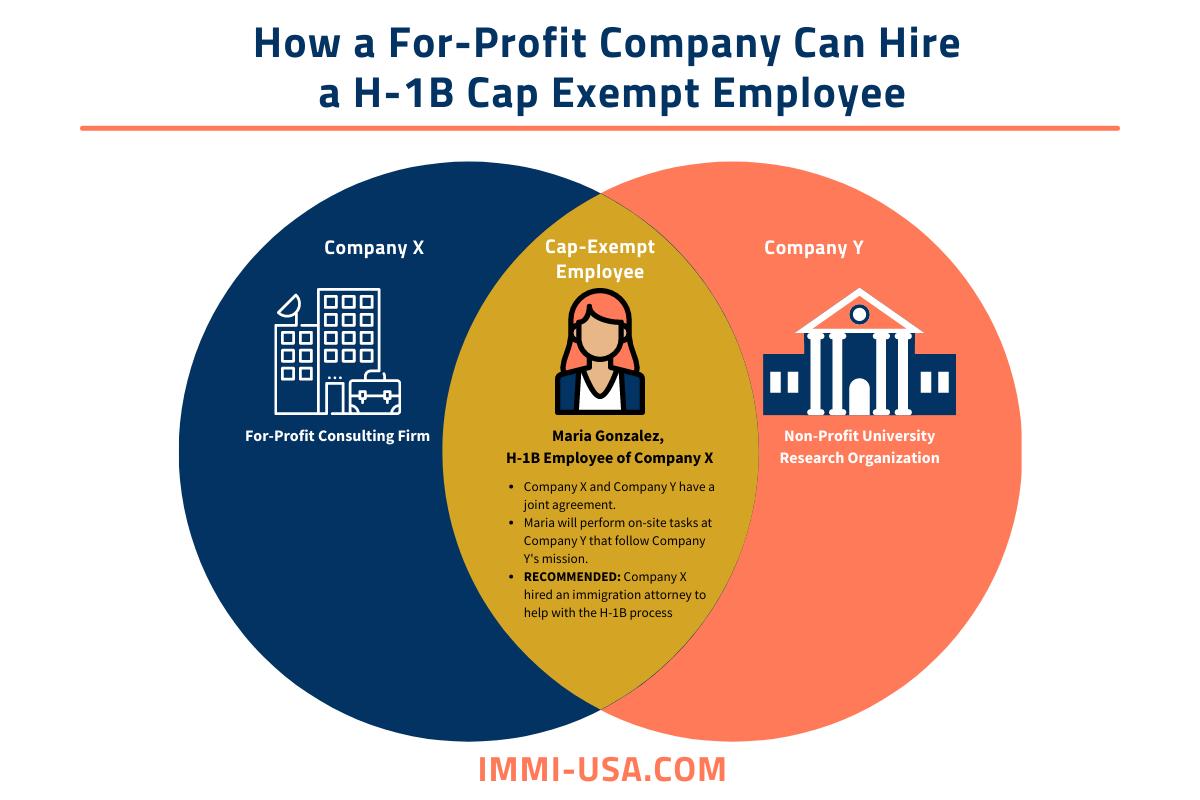
How to Apply for H-1B Cap-Exempt Visas:
Since H-1B cap-exempt visa applications can be filed at any point during the calendar year, you don’t need to abide by specific application windows (no filing deadline or limit to petitions accepted).
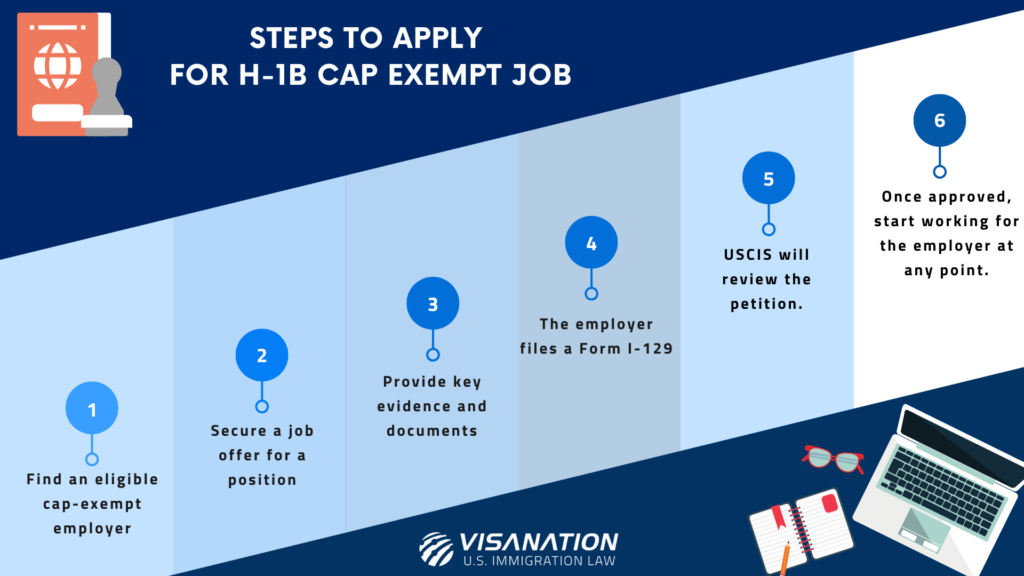
The Application Process for H-1B Cap-Exempt Visa Step-by-step:
- Find an eligible cap-exempt employer such as a non-profit organization, research institution, or government entity.
- Secure a job offer for a position closely related to your educational background or degree.
- Work with your employer to provide key evidence and documents for the H-1B cap-exempt application (I-129) such as your passport, academic transcripts, and any other documentation related to your qualifications for the specific job, such as a CV thoroughly detailing work experience and skills.
- The employer files a Form I-129 (Petition for a Nonimmigrant Worker) with USCIS, demonstrating that the position qualifies as cap-exempt and the role meets the H-1B eligibility criteria.
- USCIS will review the petition.
- Once approved for the visa, you can start working for the employer at any point.
For legal support with H-1B petitions and cap exemption, contact VisaNation Law Firm attorneys
What is the H-1B Cap-Exempt Processing Time?
The H-1B cap-exempt processing time varies from case to case but generally takes about seven months on average. This timeline includes:
- The processing of the Labor Condition Application by the Department of Labor
- USCIS Processing times
It’s important to note that this is an average estimate and actual processing times can be shorter or longer depending on the specific details of each case.
How to check H-1B Cap-Exempt Processing Time
Applicants and employers are advised to regularly check the USCIS website for the most current processing times, as these can fluctuate based on workload and other factors. You can do this by inputting the details in the USCIS processing time tool as follows:

H-1B Cap-Exempt Timeline
One significant advantage of the H-1B cap-exempt category over the regular H-1B process is that it is not subject to the H-1B lottery and the associated timeline:
With the regular H-1B process:
- Applicants spend February and March registering for the lottery
- They must wait to find out if they have been selected, and then employers must file their petitions if chosen.
- Even if approved, these regular H-1B visa holders often cannot commence employment until October 1 of that year.
- That totals about 9 months of waiting!
With the H-1B cap-exempt category:
- Employers can hire foreign workers year-round.
- Employees can start working immediately after visa approval.
This flexibility makes the cap-exempt process a game-changer for both employers and employees.
The below infographic visualizes this:
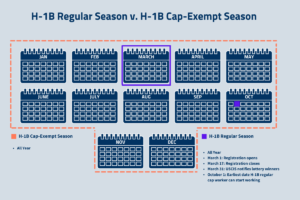
H-1B Cap-Exempt Employers List
The following is a list of past H-1B cap-exempt employers. It’s important to confirm that these are still eligible organizations, as things may change.
Note: The lists below are samples of various cap-exempt categories, but not the entire lists.
H-1B Cap-Exempt Institutions – Higher Education
|
H-1B Cap Exempt Employers’ List |
Website |
|
Georgia Institute of Technology |
|
|
University of Michigan |
|
|
California Institute of Technology |
|
|
University of California, Los Angeles (UCLA) |
|
|
Howard University |
|
|
Princeton University |
|
|
Massachusetts Institute of Technology (MIT) |
|
|
University of California, San Diego |
|
|
University of Southern California |
|
|
Carnegie Mellon University |
Non-Profit Organizations Associated with Institutions of Higher Education
|
Non-Profit Organizations Associated with Institutions of Higher Education |
Website |
|
National Bureau of Economic Research |
|
|
Mayo Clinic |
|
|
Research Corporation Technologies |
|
|
Smithsonian Institution |
|
|
American Association of University Women |
|
|
American Chemical Society |
|
|
American Physical Society |
|
|
National Academy of Sciences |
|
|
American Speech-Language-Hearing Association |
|
|
Association of American Medical Colleges |
Cap-Exempt Governmental Research Organizations
|
Cap-Exempt Governmental Research Organizations |
Website |
|
Los Alamos National Laboratory |
|
|
Lawrence Livermore National Laboratory |
|
|
Sandia National Laboratories |
|
|
Fermi National Accelerator Laboratory |
|
|
Jet Propulsion Laboratory |
|
|
National Renewable Energy Laboratory |
|
|
Pacific Northwest National Laboratory |
|
|
Oak Ridge National Laboratory |
|
|
National Institutes of Health |
|
|
Brookhaven National Laboratory |
Where Can I Find H-1B Cap-Exempt Employers?
A helpful site to find H-1B Cap-Exempt employers and jobs is MyVisaJobs.com with their H-1B Visa Sponsor Database. On the right-hand side, when searching through the database, you can select “cap-exempt.”
You can also filter industry code (NAICS), work city, visa rank, and job titles. Note that we assume no responsibility for the accuracy of the job listings or positions listed on this website. It is highly recommended to retain a professional immigration attorney who knows the regulations and restrictions outlined by USCIS pertaining to H-1B positions.

Additional H-1B Job Databases:
- USCIS H-1B Data employer hub: This data hub includes data from fiscal year 2009 onwards on employers who have submitted petitions to employ H-1B nonimmigrant workers
- H1Bgrader: Provides useful lists such as top H1B Sponsors, job titles, and cities.
- HigherEdJobs: Discover roles in higher education and associated non-profits
- Glassdoor and Indeed: Use keywords like “cap-exempt H-1B,” “university,” “nonprofit,” or “research institution.”
- NGO Job Board: Focuses on jobs in non-governmental organizations, especially in Washington, D.C.
- Impactpool: Offers international job opportunities, including positions with G4 visas for employees of international organizations.
Does Premium Processing Expedite H-1B Cap-Exempt Applications?
Yes! Premium processing guarantees a 15-day processing timeline once USCIS receives Form I-907, Request for Premium Processing Service. You can choose premium processing when filing your application, or you can add it later on by upgrading after receiving the receipt notice. The cost for premium processing is $2,500.
Within those 15 days, USCIS will either:
- Approve
- Issue a denial notice
- Issue notice of intent to deny
- or request for evidence (R.F.E) for your case.
If they request you send additional documents and evidence, a new 15 calendar period will begin when they respond to the request for evidence.
How Long is a Cap-Exempt H-1B Visa Valid?
A cap-exempt H-1B visa is valid for up to six years. An employer may file a cap-exempt H-1B petition for an employee if they previously held H-1B status in the U.S. and haven’t used their six years of status. The petition would be valid for the remainder of the employee’s allowed time in the U.S.
Example 1
Employee Juan Valdez was in the U.S. with H-1B status from February 15, 2003, to December 1, 2006. Would he be able to file for a new H-1B cap-exempt petition?
Answer:
Yes, Juan would be eligible to file for a new H-1B cap-exempt petition. This is because he has not yet reached the six-year limit on his H-1B status. Since he used less than three years of the six years available to him, he can apply for a cap-exempt H-1B and use the remaining time.
Example 2
Siddhartha was in the U.S. on H-1B status from November 3, 2010, to December 5, 2016. Would he be able to file for a new H-1B cap-exempt petition?
Answer:
No, Siddhartha would not be eligible for a new H-1B cap-exempt petition. He used his full six years of H-1B status from 2010 to 2016. Because he has already reached the six-year limit, he would need to go through the regular H-1B lottery process when applying for a new visa.
It’s worth noting that these six years can be reset if you have been out of the U.S. for one year; then you can file another H–1B under the quota.
To learn more about a scenario like this or something similar, you can consult a qualified immigration attorney specializing in cap-exempt H-1B situations.
For legal support with H-1B petitions and H-1B Cap exemption, contact VisaNation attorneys
H-1B Cap-Exempt Transfer
An H-1B transfer allows individuals with H-1B visa status or previous H-1B visa status to transfer to a different employer. While it varies in some cases, processing for an H-1B transfer typically takes four to eight months after applying to USCIS.
As the H-1B visa holder, you do not have to receive permission from the former employer, though you should follow non-compete laws or any other contractual agreements with the employer. For the H-1B visa holder to change employers, the new employer must submit an H-1B Visa Transfer petition with the USCIS.
The H-1B visa transfer requirements:
- Must start employment within 30 days of the date indicated on the H-1B Transfer petition submitted to USCIS.
- You can begin working the day the employer receives the receipt from the USCIS.
- If you have incurred a gap in employment (ceased employment with an H-1B employer before transfer), it is advised to file premium processing.
- You must also provide pay stubs as evidence of employment; however, it is possible to submit other documentation, i.e., a letter from the H-1B employer or a leave of absence letter.
For legal support with H-1B petitions and cap exemption, contact VisaNation Law Firm attorneys
Transferring to or from an H-1B Cap-Exempt Employer
There are many instances of people wishing to transfer across employer exemption lines. While the advantages of entering the U.S. under a cap-exempt employer and transferring to a cap-subject employer seem promising, the reality is that this is not a loophole that people can exploit.
If your current employer is cap-exempt and you want to transfer to a cap-subject employer, the new employer must file an H-1B cap petition for you. This is because you’ll no longer qualify as a cap-exempt candidate and haven’t yet been counted toward the H-1B cap. In other words, you will need to participate in the H-1B visa lottery.
- See our guide on H-1B lottery chances.
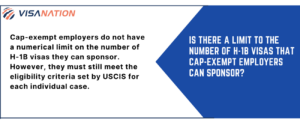
The new employer will enter you into the lottery based on the educational requirements of the position. If USCIS selects your petition, you can begin working for the cap-subject employer simultaneously. It’s also essential to be conscious of any contracts or agreements you’ve signed with non-compete clauses to avoid repercussions.
Is the H-1B Transfer Cap-Exempt?
Under the H-1B Portability Rule, an H-1B visa holder can change employers and start working for the new employer the day USCIS receives the new employer’s H-1B transfer petition. However, you must file this new petition before the H-1B holder’s visa expires.
According to the U.S. Department of Labor (DOL), “The portability provision is intended to preserve the legal status of an H-1B nonimmigrant who is already in the U.S.. Portability allows the employed H-1B worker to enter into employment with a new employer provided that:
- The new employer has filed a non-frivolous Petition for a Nonimmigrant Worker (Forms I-129/ I-129W) for the employment of the H-1B worker before the date of expiration of the worker’s authorized period of stay; and
- The new employer has submitted, along with its petition, an unexpired, approved Labor Condition application (LCA) covering the same work that the individual is being hired to perform. The new employer may already hold an applicable LCA, or may have sought and received a new LCA in order to submit the petition.”
If you already have a cap-exempt job and want to transfer to a different job that also is cap-exempt, then you can file an H-1B transfer at any point and begin the new position after the H-1B transfer filing has been submitted to USCIS.
Another situation where the H-1B Portability Rule would come into play is when a cap-subject employee worked at a cap-exempt position and wanted to transfer to a new position. Then the new job would not be subject to the H-1B cap. Therefore the transfer could be filed whenever they wanted.
As you can see, the portability rule is quite complex. If you’re seeking an H-1B transfer, speak with an H-1B lawyer at VisaNation Law Group first. The last thing you want to do is submit transfer documents and have them denied because of errors on your part.
For legal support with H-1B petitions and cap exemption, contact VisaNation Law Firm attorneys
Legal support for H-1B Cap-Exempt Visas – Check With Lawyers
Support from an attorney with experience in H-1B Cap-Exemption can ensure compliance and proper filing. Both employers and employees can benefit from a lawyer’s expertise in filing petitions and addressing challenges. A few ways a lawyer can provide support for both employers and employees:
H-1B Cap-Exempt legal support for Employers:
- Determining Cap-Exempt Eligibility – Lawyers can determine whether your organization or role qualifies as a cap-exempt, and provide guidance on eligibility.
- Filing petitions: Lawyers can support employers to file petitions that abide by USCIS guidelines, and prepare documentation to prove cap-exemption status.
- Handling Requests for Evidence (RFEs) – Lawyers can offer guidance and draft responses to provide evidence for cases that require requests for evidence.
H-1B Cap-Exempt legal support for Employees
- Lawyers can guide employees in verifying employers are cap-exempt.
- Offer advice and guidance for transferring.
- Exploring alternative visa options.
For legal support with H-1B petitions and H-1B Cap exemption, contact VisaNation attorneys
Frequently Asked Questions (FAQS)
Below you will find answers to the most commonly asked questions about the topic:
What is the difference between cap and cap-exempt?
The difference between cap and cap-exempt is cap-exempt do not need to participate in the H-1B Visa lottery. These are some key differences:
-
Cap H-1B Visa
- The employee must participate in the H-1B Visa lottery.
- The application is subject to the annual cap, and selection is based on a random lottery system.
-
Cap-Exempt H-1B Visa
- The employee does not need to participate in the H-1B Visa lottery.
- These visas are not subject to the annual cap.
- Typically granted to employees working at non-profit organizations, higher education institutions, or government research organizations.
Can I qualify for an H-1B if I’m currently a J-1 Exchange Visitor?
Some J-1 Exchange Visitors cannot get H-1B status until meeting the two-year, home-country physical presence requirement or USCIS waives it. If this two-year home country requirement doesn’t apply to your situation, you could be eligible for H-1B status. The best person who can determine this is a qualified immigration lawyer.
Do I receive protections under the H-1B program as an H-1B cap-exempt worker?
All H-1B immigrants are entitled to protections under the H-1B program including the provisions as they pertain to regulations, wages, whistleblower protections, etc. Discuss this more with your immigration attorney if you have specific questions related to your rights under federal immigration laws.
Are there advantages for an employer to hire an exempt H-1B petitioner?
While the specific advantages may vary on a case-by-case basis there are some explicitly outlined by the U.S. Department of Labor Fact Sheet #62Q, “H-1B-dependent and willful violator employers which employ only exempt H-1B workers on a Labor Condition Application (LCA) are relieved from the additional obligations with which they would otherwise be required to comply: non-displacement, recruitment, and hiring.”
What does Cap-subject mean?
If you hear the term cap-subject thrown around that means the employer is not cap-exempt. So how are visas specifically allotted for cap-subject and advanced degree petitioners? The regular H-1B visa cap dedicates 65,000 petitions to foreign workers with the required skills and qualifications. USCIS allotts an additional 20,000 petitions to individuals holding advanced degrees at a master’s level or beyond. However, in some cases, you can file H-1B applications without going through the H-1B cap.
Is it possible to get an H-1B while out of the U.S.?
An employer can apply for your H-1B visa even while you’re living outside of the U.S. After it’s approved, you need to get an H-1B visa stamp at the U.S. Consulate or Embassy in your home country, and then you can legally enter the U.S.
Would I be able to switch jobs after I get an H-1B visa?
H-1B transfers are possible. However, if you decide you want to change employers after getting H-1B status, you’ll need the new employer to file a petition on your behalf. The exception is if you’re cap-exempt and moving to another cap-exempt employer. The most significant benefit of the H-1B Portability rule is that it lets H-1B workers switch jobs without any risk of being out of status. What’s more, an employer can employ a foreign worker sooner than they usually would.
Find out about different types of green cards in the U.S.
For legal support with H-1B petitions and H-1B Cap exemption, contact VisaNation attorneys
What are the benefits of the H-1B visa?
There are several unique advantages of applying for the H-1B visa through cap-exempt organizations:
- You can begin working as soon as the visa is approved.
- Many people ask whether they can apply for a green card while on a cap-exempt H-1B Visa. As the cap-exempt H-1B visa is a dual intent, you can apply for a green card and pursue permanent residency while working with this visa
- You can bring your spouse and children with you on an H-4 visa.
- You can switch employers without losing your visa status.
Disadvantages of the H-1B visa:
- If you don’t have an interest for non-profit work or research, cap-subject employers may be a better option for you.
- Switching to a cap-subject employer is a risk, as it requires starting the application process anew and going through the H-1B visa lottery. See your chances.
What is a specialty occupation?
A specialty occupation is defined as one requiring “theoretical and practical application of a body of specialized knowledge and attainment of a bachelor’s degree or higher in the specific area of work.” Most commonly, these areas of specialty include the sciences, computer programming, and engineering. In past years, the top H-1B visa occupations, according to myvisajobs.com, were software developers, computer analysts, operations research analysts, mechanical engineers, accountants and auditors, financial analysts and statisticians, and database administrators.
Can my wife/spouse and children get a dependent visa after I’m approved on H-1B?
By law, an H-1B holder’s spouse and dependents, children under 21 years old, can apply for H-4 status. In some instances, H-4 holders can also get the ability to work (Employment Authorization Document, or EAD)
What is the minimum salary for a cap-exempt H-1B?
The minimum salary for a cap-exempt H-1B visa must be $60,000 or more per year, although it can be higher depending on the job role, location, and the employee’s qualifications. Employers must pay at least the prevailing wage set by the Department of Labor (DOL), which is based on these factors. The employer must meet or exceed this wage or their proposed wage, whichever is higher. The wage details are submitted on the Labor Condition Application (L.C.A.) form. Employers must also confirm that hiring a foreign worker will not displace U.S. workers.
How to go from an H-1B Cap-exempt Visa to a Green card?
- Employer Sponsorship: Your employer must sponsor your Green Card application.
- Labor Certification (PERM): The employer must obtain Labor Certification from the U.S. Department of Labor, proving no qualified U.S. workers are available.
- File I-140: After PERM approval, your employer files Form I-140 with USCIS to establish your eligibility.
- Priority Date & Visa Bulletin: Wait for your priority date to become current based on your country’s visa bulletin.
- Adjustment of Status (I-485): Once eligible, file Form I-485 to adjust to permanent residency. If outside the U.S., go through consular processing.
- Green Card Approval: After I-485 approval (or consular interview), receive your Green Card.
Can I file the H-1B application myself if I don’t have an employer yet?
You cannot file it. Only the U.S. employer can file on your behalf.
I’m in the U.S. on an H-1B visa, and it just expired. What do I do?
There’s a distinction between your visa stamp and your immigration status in the U.S. Your immigration status dictates how long you can remain in the U.S. Your visa is simply a travel document. If the visa found in your passport expires, that doesn’t necessarily mean you have to leave the country right away because your legal status depends on the I-94 expiration date. As long as your I-94 is valid, then you can continue working in the U.S. for your H-1B sponsoring employee. If you are outside of the U.S. and the visa in your passport expires, then you should go to your U.S. consular to apply for a new H-1B visa.
Are there certain types of jobs that are harder to get on H-1B status?
There isn’t a definitive answer to this question per se but some positions like those in sales may be challenging to obtain because they don’t have cut-and-dry training required like some more structured positions.
Can I extend my H-1B past the six-year max?
There are certain situations where you could extend your visa past the six-year limit, and those include if you filed your PERM Labor certification or I-140 at least 365 days prior, then you could get an H-1B extension in one-year increments. Likewise, if USCIS approves an I-140, you can obtain an extension in three-year increments assuming the priority date isn’t current.
Can I travel while I have an amendment pending on my H-1B?
You can travel with it pending as long as there is a valid H-1B visa stamp and approved petition ready for your re-entry. As a safeguard, take the amendment receipt notice with you on your travels in case of any issues at reentry. If USCIS approves your amendment while you’re traveling, your employer can forward it to you to use at the port of entry. Due to the current travel restrictions caused by the pandemic, it may be wise to consult with an H-1B lawyer before traveling without an approved H-1B amendment.
Can I get premium processing after filing the H-1B?
Yes, you can select premium processing while filing or, at a later time, upgrade to it after getting the receipt notice. The 15-day guaranteed processing period begins when USCIS receives Form I-907, Request for Premium Processing Service. Within that period, USCIS will either approve, issue a denial notice, notice of intent to deny, or request for evidence for your case. If they request you send additional documents and evidence, a new 15 calendar period will begin when they respond to the R.F.E. The cost for premium processing is $2,500.
Does premium processing make me cap-exempt?
No, it does not but the advantage is that it reduces processing time down to 15 days for a service fee of $2,500. We recommend using the premium processing service if you’re interested in a cap-exempt transfer and have a gap in employment.
Can any non-profit organization sponsor me?
To qualify as an H-1B cap-exempt non-profit research or government research organization, the organization must meet the definition of a non-profit entity and its requirements:
- Connected or affiliated with an institution of higher learning via shared ownership or control by the same board.
- Completely operated by the higher learning institution
- Connected to higher learning institutions through the non-profit being a member, subsidiary, branch, or cooperative.
- Must have entered into a contractual agreement with the institution that establishes a relationship between them (the non-profit) and the institution for education or research.
Do cap-exempt employers pay the ACWIA fee for H-1B petitions?
No. Cap-subject H-1B employers must pay the ACWIA education and training fee. Cap-exempt employers do not need to pay this fee. Moreover, according to USCIS, the ACWIA fee is also not required when:
- A petitioner files its second or subsequent request for an extension of stay with the same employer;
- A petitioner files an amended petition that doesn’t contain any requests to extend the validity of the petition; or
- USCIS makes an error and you file a petition to correct the error. However, to be considered exempt from the ACWIA fee, such petitions may not contain any requests to extend the validity unless the USCIS error involves the validity dates.
Can cap-exempt employers sponsor H-1B visas for foreign workers indefinitely?
Cap-exempt employers can sponsor H-1B visas with more flexibility, but there are still certain limitations. As long as they meet the criteria set by the USCIS for each case, they can sponsor H-1B visas without being subject to the annual cap.

